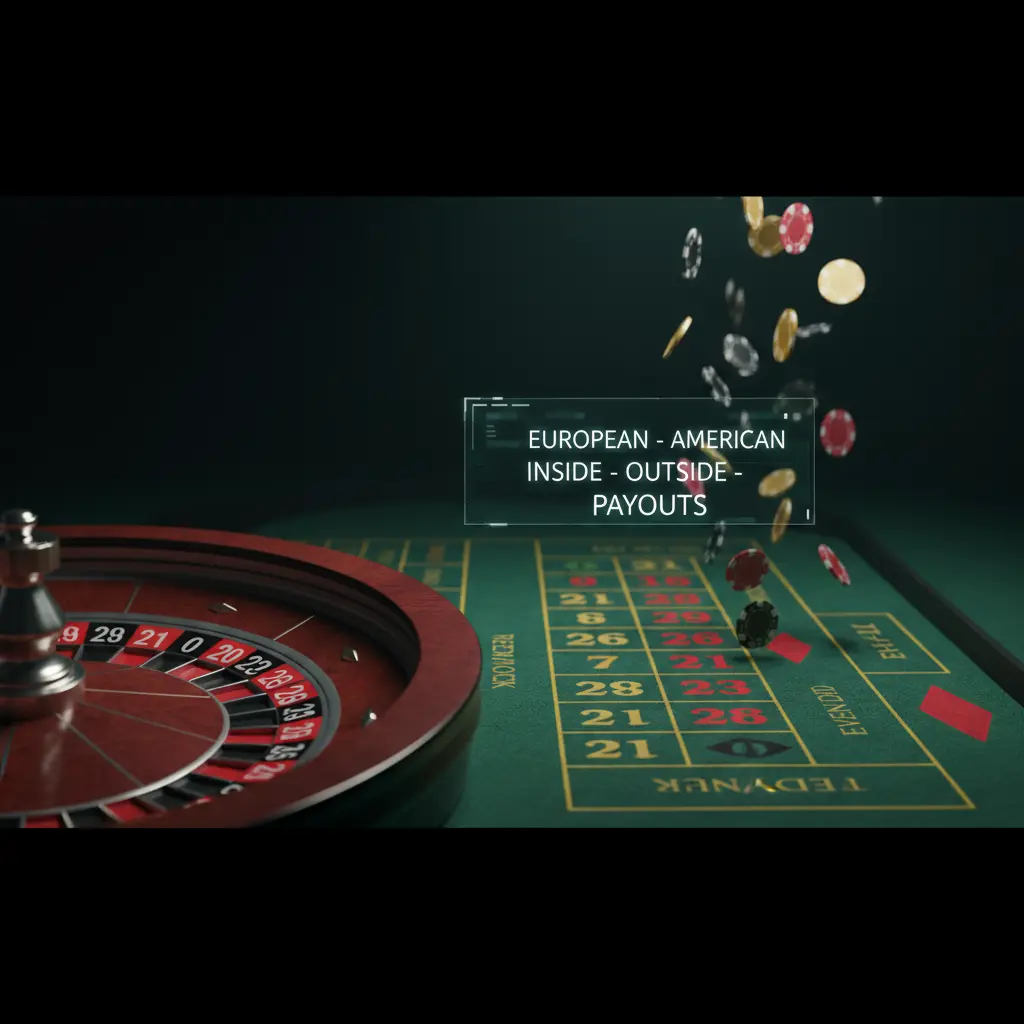Ready to conquer the roulette wheel? You’ve come to the right place. The secret to moving from a novice player to a confident strategist isn’t a magic trick—it’s understanding the numbers. The most critical factor is grasping the roulette odds. This single concept dictates your chances of winning, how much you can get paid, and the casino’s built-in advantage.
In this guide, we’ll break down everything you need to know in simple terms. We’ll start with the crucial difference between European roulette and American roulette, explore the various inside bets and outside bets, and demystify the payout table. By the end, you’ll understand the house edge and know how to use popular betting systems to play smarter.
You Also Like This: Texas Hold’em Poker: Rules, Hand Rankings, and Smart Strategy
You May Like This: Sports Betting 101: Your Ultimate Sports Betting Guide to Odds, Markets, Parlays, and Live Betting
The Basics: Understanding the Roulette Wheel and Table
At its core, roulette is a game of captivating simplicity. A dealer, or croupier, spins a wheel in one direction and a small ball in the other. Your job is to predict which numbered pocket the ball will land in. The fundamental roulette rules are consistent whether you’re playing online or in a physical casino. Before the spin, you place chips on a betting mat that corresponds to the numbers on the wheel. The game comes in two main digital formats: RNG roulette, where a computer’s Random Number Generator determines the outcome, and live roulette, which streams a real dealer and a physical wheel for a more immersive experience.
You Also Like This: Online Casino 101: RTP, RNG, Volatility, and House Edge Explained
American vs. European Roulette: A Crucial Choice for Your Roulette Odds
Before you place a single chip, the most important decision you’ll make is which type of roulette to play. The difference seems tiny—just one extra pocket—but it dramatically impacts your roulette odds and, ultimately, your chances of winning.
European Roulette: The Player’s Choice
Often called single zero roulette, the European wheel has 37 pockets: numbers 1-36 and a single green ‘0’. That single zero is what gives the casino its advantage. Because of this structure, the house has a relatively small edge. In some French versions of the game, you’ll find player-friendly rules that improve your odds even more:
- La Partage: French for “the divide.” If you make an even-money bet (like red or black) and the ball lands on zero, you get half of your stake back. This simple rule cuts the house advantage on those bets in half.
- En Prison: Meaning “in prison.” Similar to La Partage, on an even-money bet, if the ball lands on zero, your bet is “jailed” for the next spin. If your bet wins on that next spin, you get your original stake back. If it loses, the house takes it.
You Also Like This: Casino Bonuses Explained: Your Ultimate Guide to Wagering, Rollover, and How to Choose the Best Offers
American Roulette: The Double Zero Disadvantage
The American wheel, or double zero roulette, adds a second green pocket, the ’00’. This brings the total number of pockets to 38. Here’s the catch: the payouts for winning bets are exactly the same as in European roulette. With an extra losing pocket for most bets and no change in payouts, your odds of winning are worse. This simple addition almost doubles the casino’s built-in advantage.
House Edge Comparison: The Numbers Don’t Lie
The house edge is the mathematical advantage the casino holds. It’s the average percentage of each bet the casino expects to keep over the long run. A lower house edge means a higher Return to Player (RTP roulette) for you.
- European Roulette House Edge: 2.7% (or 1.35% with La Partage/En Prison rules)
- American Roulette House Edge: 5.26%
The takeaway is simple: Always choose European roulette when it’s available. Your money will last longer, and your statistical chance of winning is significantly better.
You Also Like This: Live Dealer Casinos: Games, Studios, Streaming, and RTP Basics.
A Player’s Guide to Roulette Bets: Inside vs. Outside
The roulette table might look complex, but all bets fall into two simple categories. Your choice depends on your appetite for risk and the payout you’re hoping for.
Inside Bets: High Risk, High Reward
These are bets placed on the inner, numbered section of the table. They cover fewer numbers, making them harder to hit, but they offer much higher roulette payouts.
- Straight Bet: A bet on a single number. It’s the riskiest bet with the highest payout.
- Example: You bet $10 on number 17. If it hits, you win $350 (35:1 payout) and get your $10 back.
- Split Bet: A bet on the line between two adjacent numbers (e.g., 8 and 9). Pays 17:1.
- Street Bet: A bet on a row of three numbers (e.g., 7, 8, 9). Pays 11:1.
- Corner Bet: A bet on the intersection of four numbers (e.g., 25, 26, 28, 29). Pays 8:1.
- Line Bet: A bet covering two adjacent streets (six numbers). Pays 5:1.
- You May Like This: Esports Betting Basics: Games, Markets, and Tournament Odds
Outside Bets: Better Odds, Lower Payouts
These are bets placed on the boxes surrounding the main number grid. They cover large groups of numbers, giving you a much higher chance of winning but with smaller payouts. They are perfect for beginners or more conservative players.
- Column Bet: A bet on one of the three vertical columns, covering 12 numbers. Pays 2:1.
- Dozen Bet: A bet on a group of 12 numbers (1-12, 13-24, or 25-36). Also pays 2:1.
- Red or Black: A bet on which color the winning number will be. Pays 1:1.
- Odd or Even: A bet on whether the number will be odd or even. Pays 1:1.
- High or Low: A bet on whether the number will be in the low group (1-18) or the high group (19-36). Pays 1:1.
You Also Like This: Online Slots Ultimate Guide: Features, RTP, Volatility and Jackpots
The Numbers Game: A Deep Dive into the Roulette Odds and Payout Table
Understanding the link between bets, payouts, and probability is the heart of a solid roulette strategy. This payout table clearly lays out what you can win and your chances of hitting each bet on both European and American wheels. Remember, a “35:1” payout means you win 35 units for every 1 unit wagered, plus you get your original stake back.
| Bet Name | Payout | Probability (European) | Probability (American) |
|---|---|---|---|
| Straight Bet | 35:1 | 2.70% | 2.63% |
| Split Bet | 17:1 | 5.41% | 5.26% |
| Street Bet | 11:1 | 8.11% | 7.89% |
| Corner Bet | 8:1 | 10.81% | 10.53% |
| Line Bet | 5:1 | 16.22% | 15.79% |
| Column/Dozen Bet | 2:1 | 32.43% | 31.58% |
| Red/Black, Odd/Even, High/Low | 1:1 | 48.65% | 47.37% |
You Also Like This: A Complete Guide to Casino Payment Methods: Deposits, Withdrawals, Speed, and Fees
Can You Beat the Casino? Exploring Roulette Betting Systems
Many players turn to betting systems hoping to find a guaranteed way to win. Let’s be clear: no system can alter the mathematical roulette odds or eliminate the house edge. Think of them as structured strategies for managing your money, not as magic bullets for winning.
Important Disclaimer: Betting systems do not guarantee profits. They are tools for bankroll management. Aggressive systems can lead to rapid losses, especially if you hit the table’s betting limits. Always play responsibly.
You Also Like This: Blackjack Strategy: From Basic Strategy to Bankroll Discipline
The Martingale System: The High-Risk Double-Up
This is the most famous system. The concept is simple: after every loss on an even-money bet, you double your stake. When you finally win, you recoup all previous losses plus a profit equal to your initial bet. The danger is that a losing streak can cause your bet size to skyrocket, quickly hitting the table limits or depleting your entire bankroll for roulette.
The Fibonacci System: A More Cautious Progression
This strategy uses the Fibonacci sequence (1-1-2-3-5-8-13…). You advance one step in the sequence after a loss and move back two steps after a win. It’s less aggressive than the Martingale, so your bets increase more slowly, but it also means you may need a few wins to get back into profit after a losing streak.
The D’Alembert System: The Low-Risk Flat Bet
Perhaps the safest system, the D’Alembert involves increasing your bet by one unit after a loss and decreasing it by one unit after a win. It’s a very flat progression designed for players who want to minimize risk and enjoy longer playing sessions with a modest bankroll.
The Truth About the Wheel Bias Myth
You might hear stories of players in the past who found “biased” wheels with physical imperfections that made certain numbers appear more often. This is the wheel bias myth. Modern casino wheels are precision-engineered and tested constantly to ensure randomness. In the online world, RNG roulette games are governed by certified algorithms, making bias impossible. Don’t waste your time looking for a biased wheel; it’s a relic of a bygone era.
Beyond the Basics: Modern Roulette and Smart Play
While you can’t change the odds, you can absolutely play smarter. Here are some practical tips to enhance your experience and protect your bankroll.
- Stick to European Roulette: We can’t say it enough. The lower house edge of single zero roulette is your best friend.
- Know the Limits: Before you play, check the table limits. This includes the minimum bet roulette requires and the maximum bet allowed. This is crucial for managing your strategy, especially if using a system like the Martingale.
- Manage Your Bankroll: This is the most important skill. Set a budget for your session—an amount you are fully prepared to lose—and stick to it. Never chase losses.
- Explore Modern Variants: For a fresh twist, check out games like Lightning Roulette. A lightning roulette overview shows that it adds random multipliers to straight-up bets, offering a chance at huge payouts (up to 500x), though the standard straight bet payout is slightly lower to compensate.
You Also Like This: Responsible Gambling: Limits, Tools, and Help Resources
Your Roulette Questions Answered: FAQs
Q1. What is the safest bet in roulette?
The safest bets are the even-money outside bets: Red or Black, Odd or Even, and High or Low. They offer the highest probability of winning (nearly 50%) but come with the lowest payout of 1:1.
Q2. Can you really win money playing roulette?
Yes, you can win money in the short term due to luck. However, because of the built-in house edge, the casino always has a mathematical advantage over the long run. The best approach is to play for entertainment and consider any winnings a bonus.
Q3. Which roulette system is the best?
No system is “best” because none can overcome the game’s inherent roulette odds. The best system is one that matches your personal risk tolerance and helps you manage your bankroll for roulette. The D’Alembert system is conservative, while the Martingale system is high-risk.
Q4. Why is American roulette worse for players?
American roulette is worse because of the extra ’00’ pocket. This increases the total pockets to 38 while keeping the payouts the same as the 37-pocket European wheel. This change effectively doubles the house edge from 2.7% to 5.26%.
Q5. What does the 0 and 00 pay in roulette?
The 0 and 00 pockets are treated like any other number for a straight bet, paying out at 35:1. However, if the ball lands on 0 or 00, all outside bets (like Red/Black, Odd/Even) lose, which is how the casino generates its house edge.
Q6. What is the difference between live roulette and RNG roulette?
Live roulette uses a real human dealer, a physical wheel, and a ball, with the game streamed to you in real-time. RNG roulette is a computer-based game where a certified Random Number Generator (RNG) algorithm determines the outcome, similar to a video game.
Q7. How do La Partage and En Prison rules work?
Found in some European roulette games, these rules benefit the player on even-money bets. With La Partage, you get half your stake back if the ball lands on 0. With En Prison, your bet is held for another spin; if it wins, you get your original stake back. Both rules reduce the house edge on those bets to just 1.35%.
Q8. What is a good starting bankroll for roulette?
A good starting bankroll for roulette is an amount you are completely comfortable losing. A smart guideline is to have enough to cover at least 50-100 times the table’s minimum bet. This allows you to withstand some losses and play for a reasonable amount of time without going broke too quickly.
Explore On: Explore On How to Choose iGaming Providers: Licensing, Game Portfolios, Tech Stack, and Support SLAs
Final Thoughts: Playing Roulette with Confidence
Roulette will always be a game of chance. The spin is random, and no strategy can predict the outcome. But that doesn’t mean you can’t play smart. By truly understanding roulette odds, the different bets available, and the critical role of the house edge, you empower yourself to make informed decisions. Always opt for European roulette, manage your money with strict discipline, and most importantly, remember that the goal is to have fun. With the knowledge from this guide, you’re now equipped to approach the wheel not just as a gambler, but as a savvy player.
With over 20 years of experience in the iGaming industry, Anilgnews provides expert analysis and in-depth content to help players and operators navigate the complexities of online gambling regulation.




